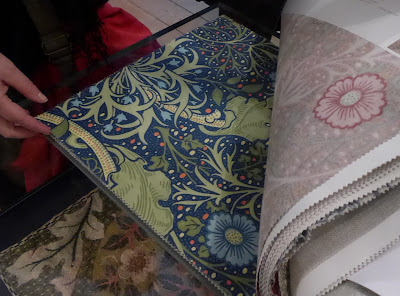Built in the 18th century, Danson House is showing a collection Vivienne Westwood's clothes very much influenced by the same period in history. As Vivienne Westwood says, "the 18th century embodies a high point in art and culture".
Before we saw this exhibition, Cut from the Past, we weren't really thinking 18th century high art and high culture, more 1970s, 1980s, and punk.
Corset and T-shirt,
also embroidered onto this T-shirt, with the print inspired by 16th century Dutch delftware.
We read that she had this pattern printed on "leggings, bodies and stockings".
"I'd forgotten all about 'bodies'. Very 1980s".
Whether I should admit to this or not... I did A'level Needlework & Dress.
This is made somewhat more embarrassing because of my grade, I only just passed. But thanks to the most inspirational teacher, Joy (for some reason I can't recall her last name), I have a love for all things needlework. It's the details...
...leg of mutton sleeves,
...buttons,
...and bows.
We had expected punk, and we got some. The Queen with her nose pierced.
Before we saw this exhibition, Cut from the Past, we weren't really thinking 18th century high art and high culture, more 1970s, 1980s, and punk.
You could see how this era had influenced Vivienne Westwood, how she'd made it her own with her Portrait Collection, working with 18th century paintings from the Wallace Collection.
Corset and T-shirt,
and her signature orb worked into the gold frame of a shawl,
also embroidered onto this T-shirt, with the print inspired by 16th century Dutch delftware.
Not just inspired by paintings, furniture captured Vivienne Westwood's imagination too, with designs inspired by marquetry, printed in red foil.
We read that she had this pattern printed on "leggings, bodies and stockings".
"I'd forgotten all about 'bodies'. Very 1980s".
This 18th century inspired gown below was once worn by Linda Evangelista. It really had been worn, there were dirty marks on the skirt.
One side of the gown was traditionally accurate with a sleeve, whereas the other was strapless.
This is made somewhat more embarrassing because of my grade, I only just passed. But thanks to the most inspirational teacher, Joy (for some reason I can't recall her last name), I have a love for all things needlework. It's the details...
...applique and bound pockets,
...buttons,
...and bows.
We had expected punk, and we got some. The Queen with her nose pierced.
"Have you got any piercings?" I asked absentmindedly.
"Yes three"
"Where?"
"My belly button"
The things you learn in museums. It's not always about the objects.
Wandering around Danson House, we perhaps found more of Vivienne Westwood's 18th century influences.
A nod to punk, off the shoulder, a touch of leopard skin.
Drapery to inspire any gown.
And wallpaper worthy of any dress.
Vivienne Westwood: Cut From the Past is on at Danson House until 31st October 2015.
Check out their website, here, for opening hours as it's not open on a Saturday.
When we went to Cut From the Past, the exhibition was a couple of pieces short. We were told they were coming. Hopefully they now have the wedding dress and 'glove' on display. We'd have loved to have seen more, plus music and photos. To hear the soundtrack, see the look, with Westwood inspired hair and makeup. To see who wore Vivienne Westwood.
"Margaret Thatcher could have been wearing that for all you know".






















































